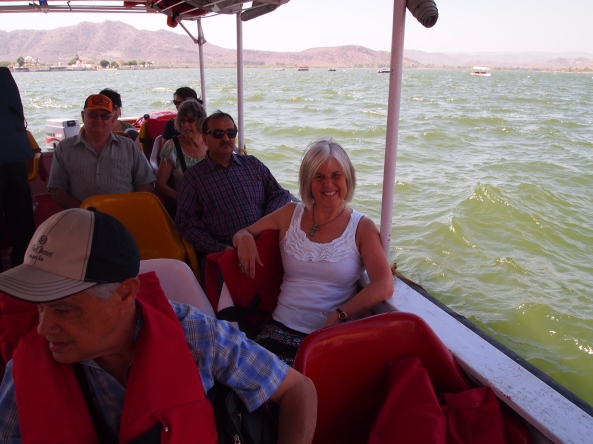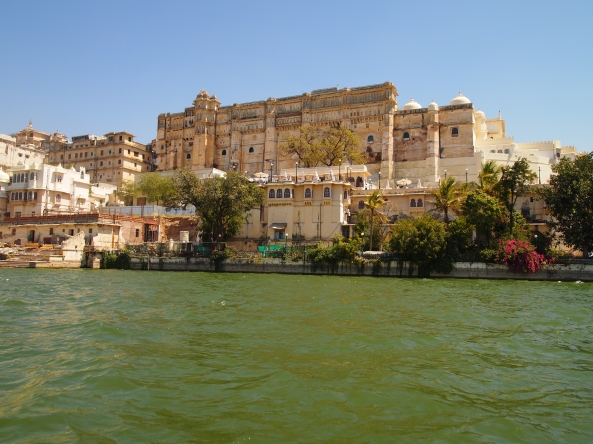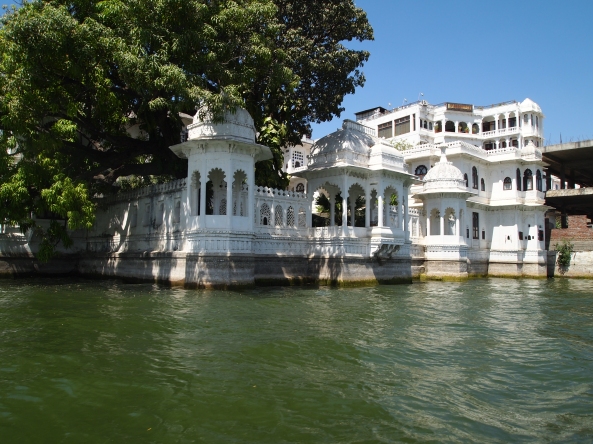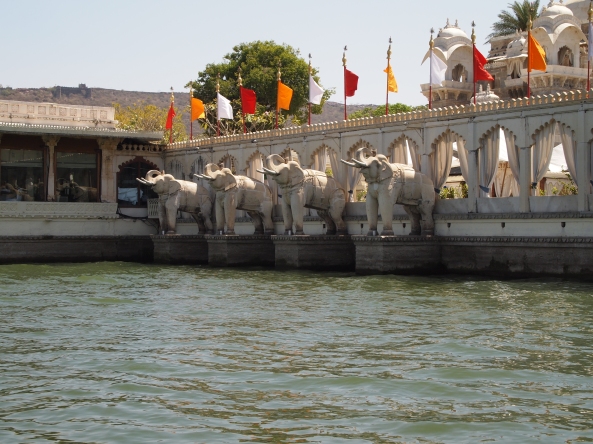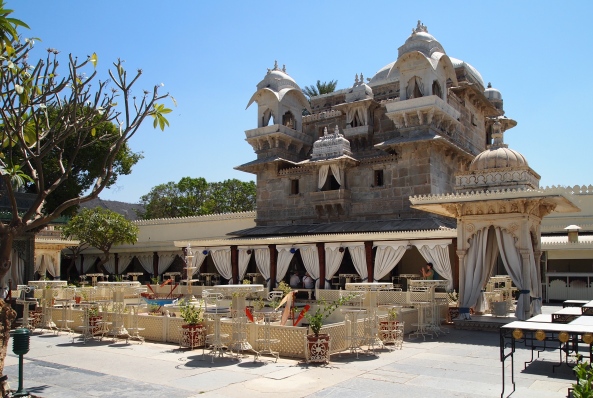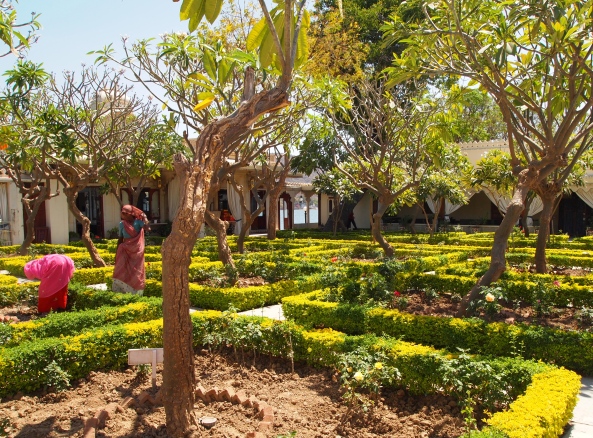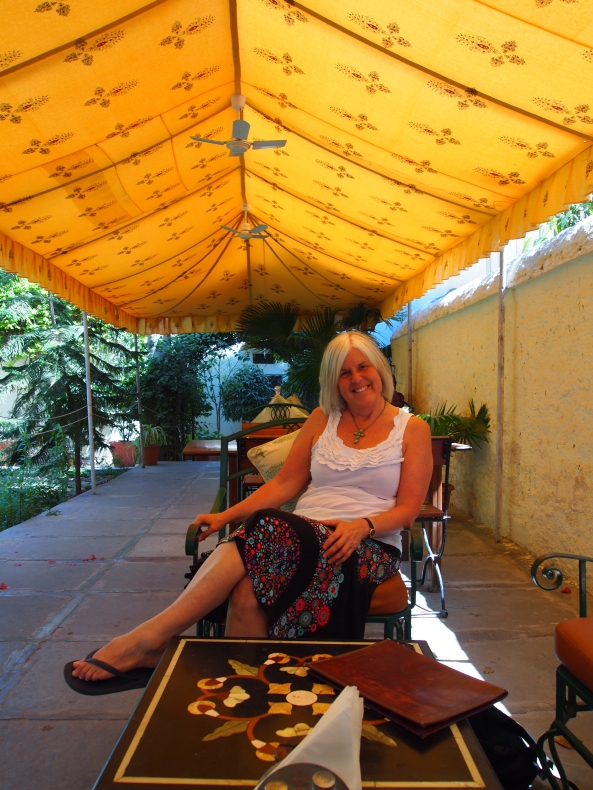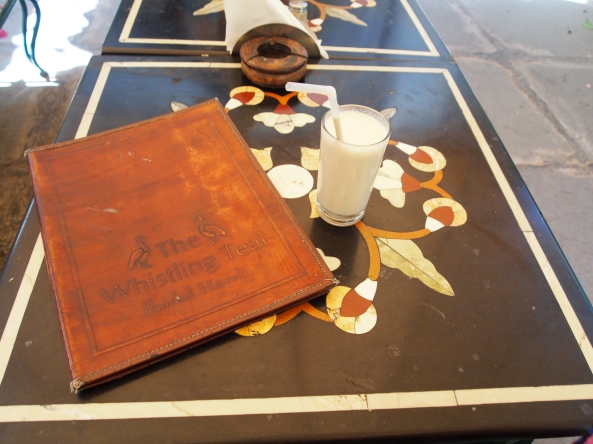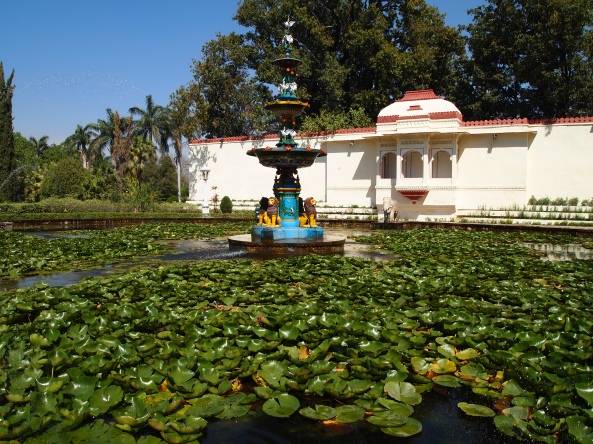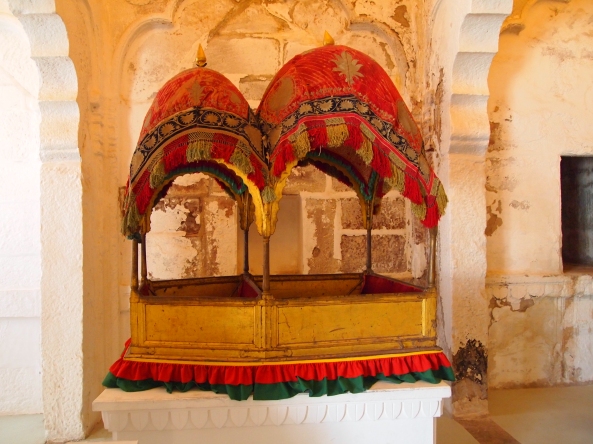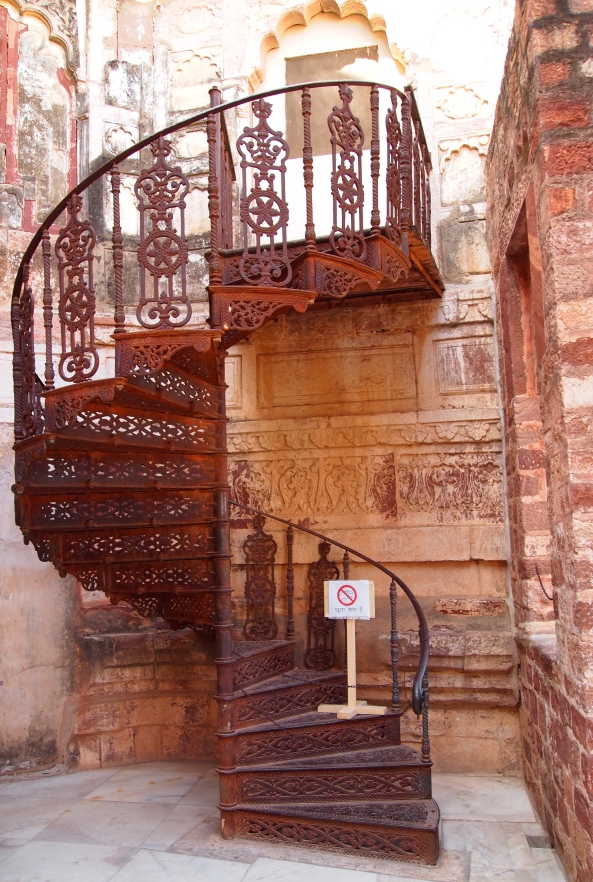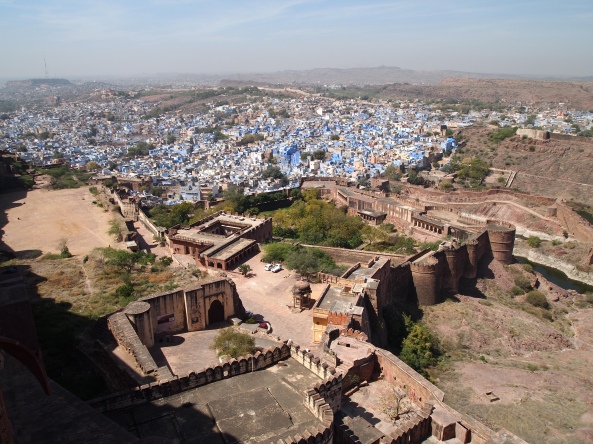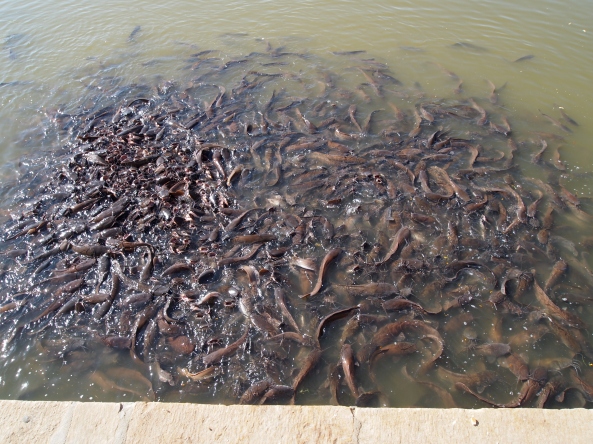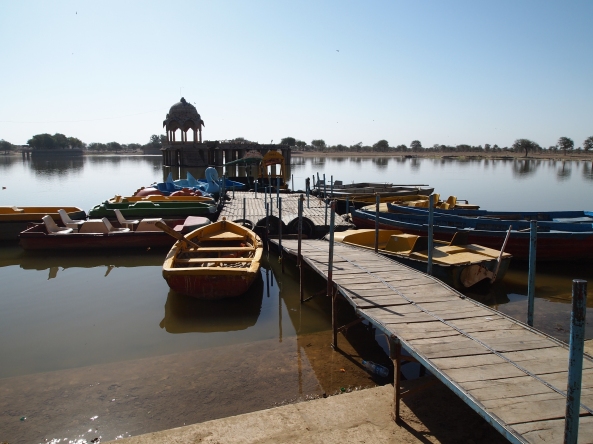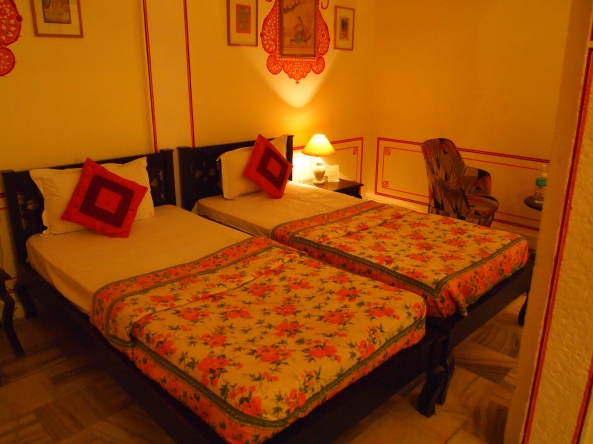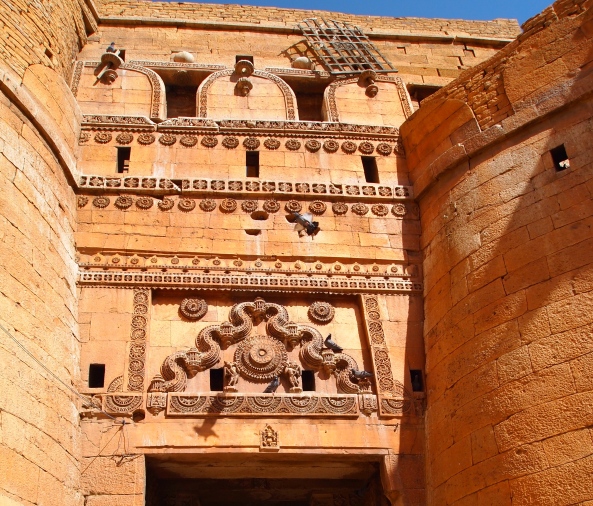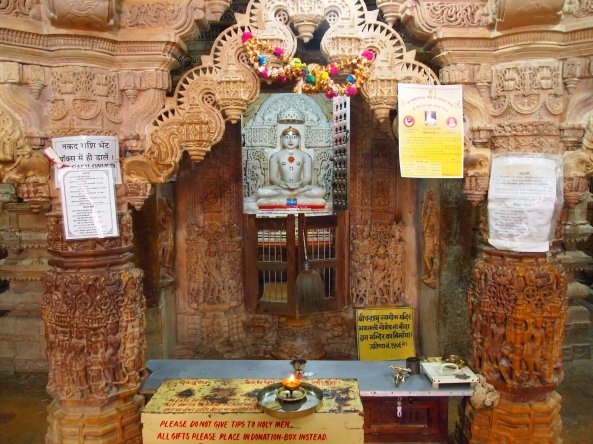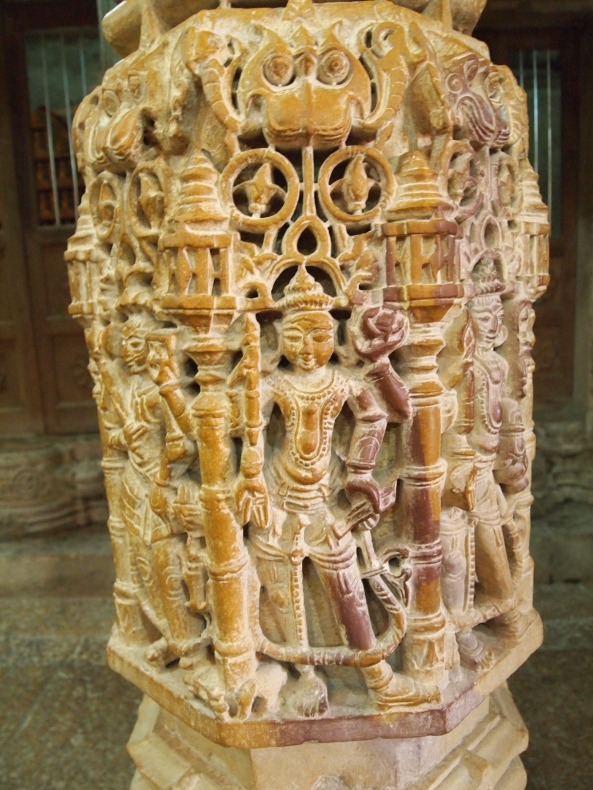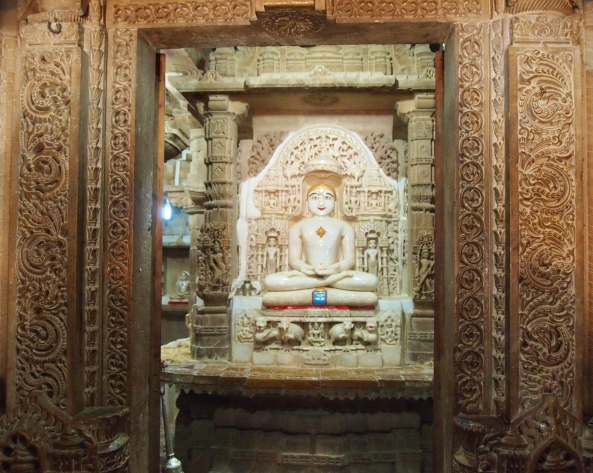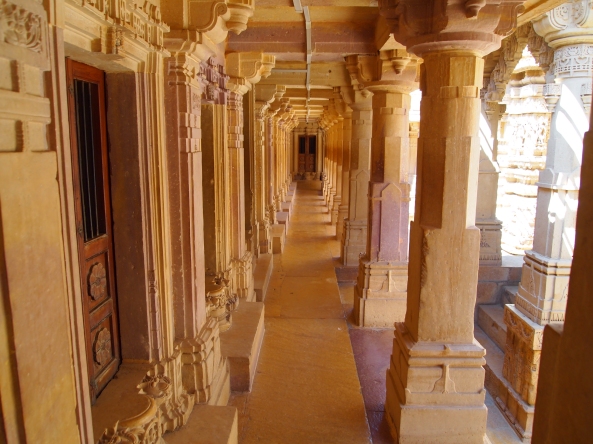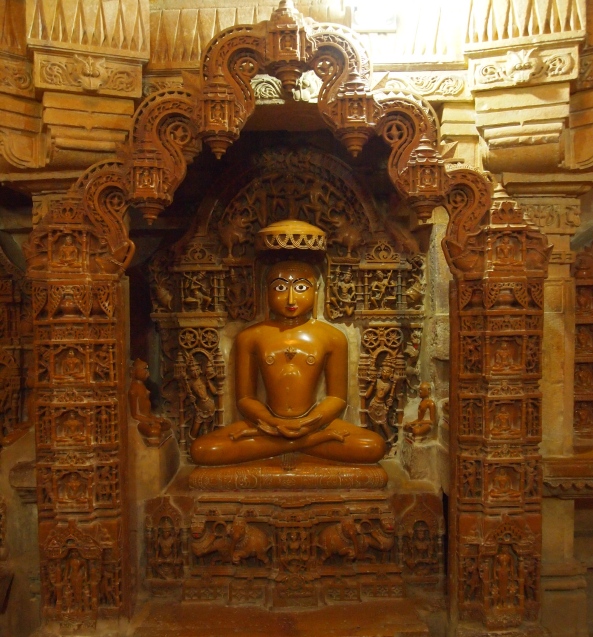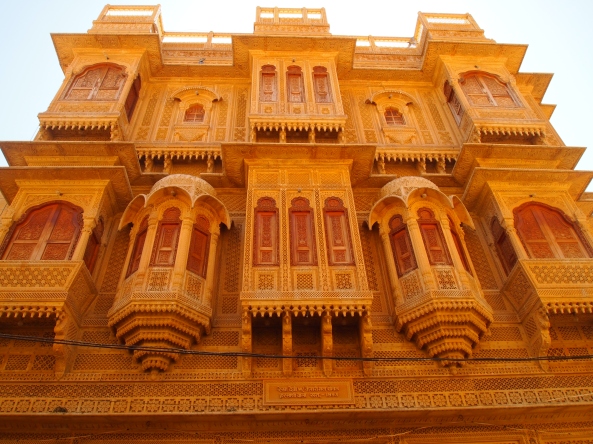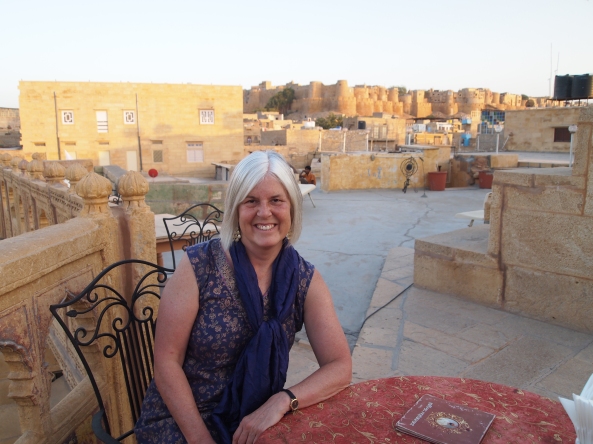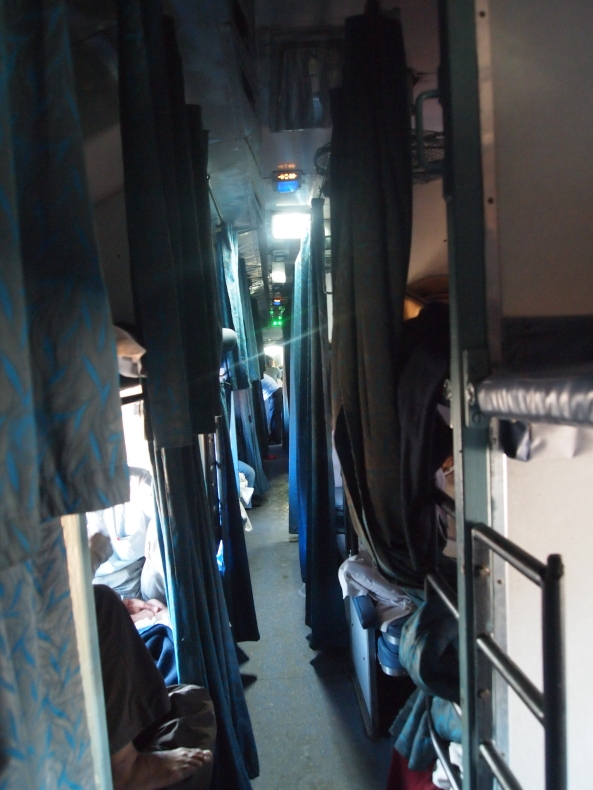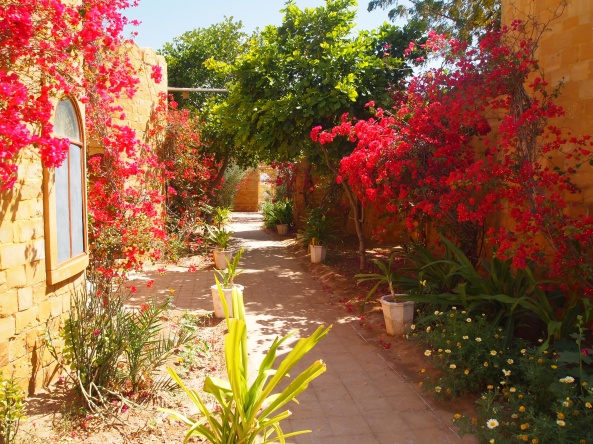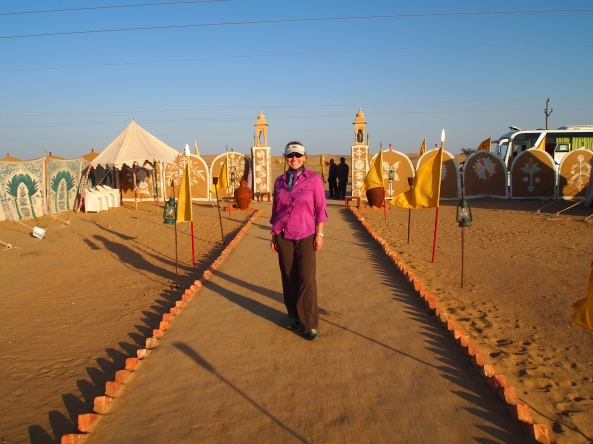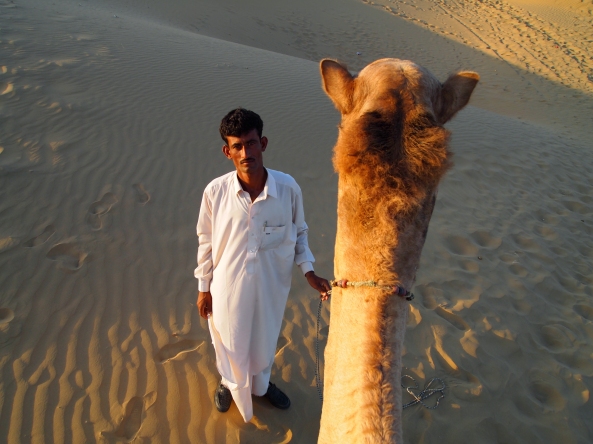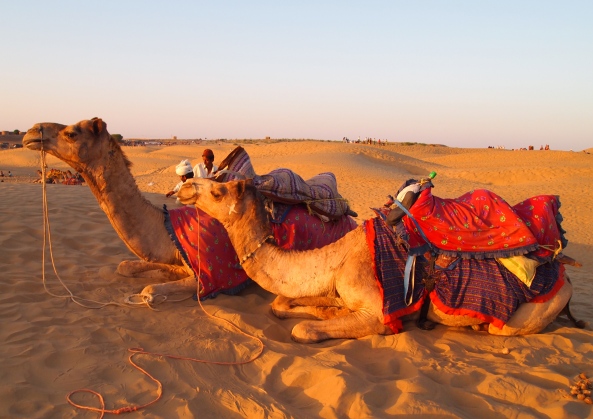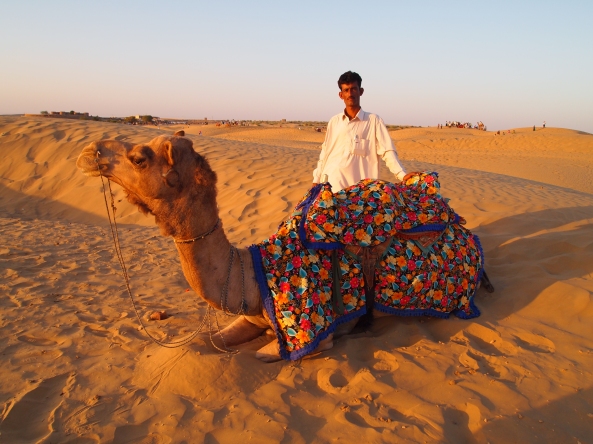Sunday, March 13: We have a fabulous breakfast in our 3rd favorite hotel in India and then take pictures of its stained glass windows, painted peacock doors, flower-painted and bejeweled ceilings, and gold-foiled arches and columns. Since this is our last day with Singh, we take pictures with him in front of his little car. We admittedly have become fond of Singh during these last 7 days, and we are sad that today we will part ways. He has grown on us, despite the early-on debacles. We will miss him dearly. Little do we know that we will no longer have such a companionable, happy-go-lucky driver for the duration of our trip.
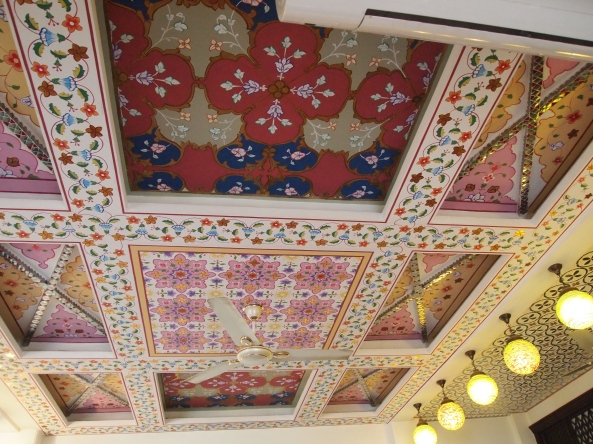
beautiful painted ceilings at the Nahargarh Haveli in Jaipur
We must check out of our room, because late tonight, at midnight, we are scheduled to take an overnight train to Jaisalmer. We leave our belongings in a spare room at the hotel and then Singh takes us to the lovely Amber (also known as Amer) Fort, 11 km north of Jaipur. This honey-hued fort palace was the ancient capital of Jaipur state.
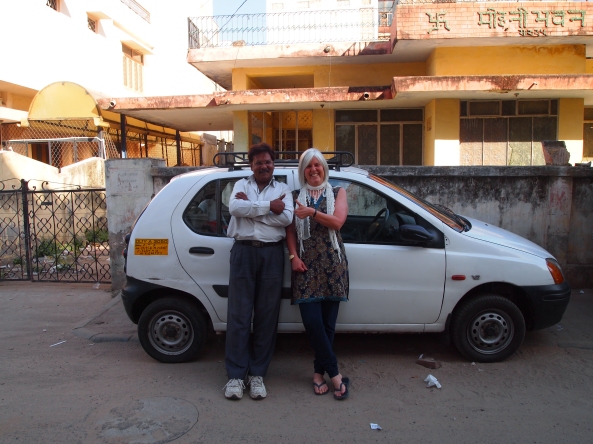
Singh and me and his little car, in which we’ve spent the last 7 days….
Maharaja Man Singh began building the Amber Fort in 1592. It is known for its artistic style, blending both Hindu and Mughal elements. The fort with its large ramparts, series of gates and cobbled paths, overlooks the Maota Lake. We climb up the fort from the road and on the way pass by caravans of brightly painted and decked-0ut elephants coming down the hill. For long moments I am transported back to a time of majestic trade caravans and maharajas. It’s quite a romantic place, one of my favorite spots in India.

Me & Jayne, with the Amber Fort behind
We enter through the Sun Gate into Jaleb Chowk, which is the first main courtyard. This was the place where armies would hold victory parades with their war bounty on their return from battles; these were witnessed by royal family women through the latticed windows.

going up the steps of the Amber Fort
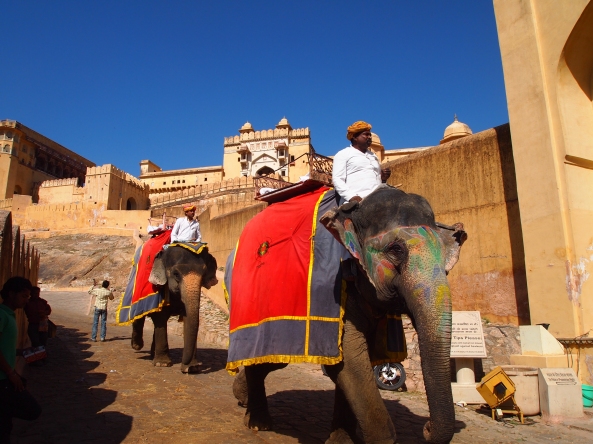
the empty elephants come down, after having dropped the tourists above
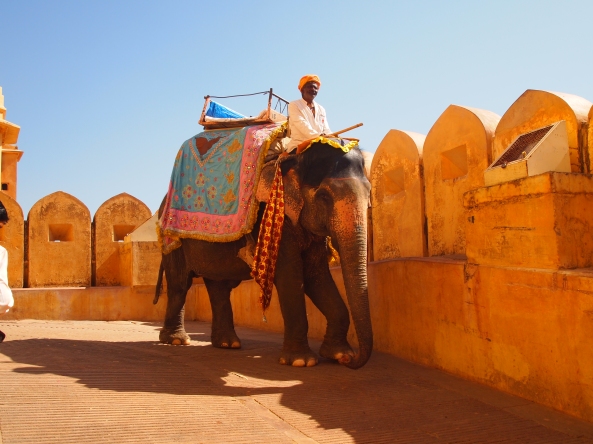
an elephant proceeds down from the Amber Fort
Once we reach the main open area of the fort, I decide to go up the main stairway through a beautiful gate painted with gold, coral, blue and green flower vases. This is one of my favorite gates with its gorgeous but faded paintings. I have to pay extra to go into this portion of the fort, and Jayne decides she would rather hang out below than to pay yet another fee. I go up to explore on my own. I am not disappointed.

one of my favorite gates at this fort
I enter a third courtyard through the Ganesh Pol or Ganesh Gate, which is embellished with mosaics and sculptures. Inside this gate is where the private quarters of the Maharaja, his family and attendants were built. The courtyard has two buildings, one opposite the other, separated by a Mughal-designed garden. The building to the left of the entrance gate is called the Jai Mandir, which is exquisitely inlaid with glass panels and multi-mirrored ceilings. Also known as Sheesh Mahal (mirror palace), the mirror mosaics and colored glasses were “glittering jewel boxes in flickering candle light.”

the mughal gardens in front of Jai Mandir, or the palace of mirrors
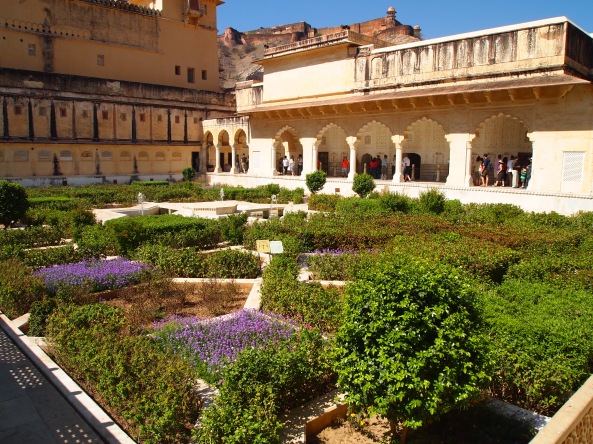
the mughal gardens
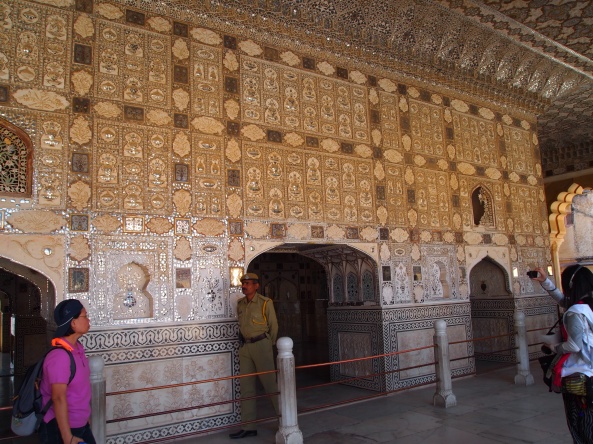
inside the palace of mirrors

Looking down from the Amber Palace

a beautiful gate at the Amber Palace
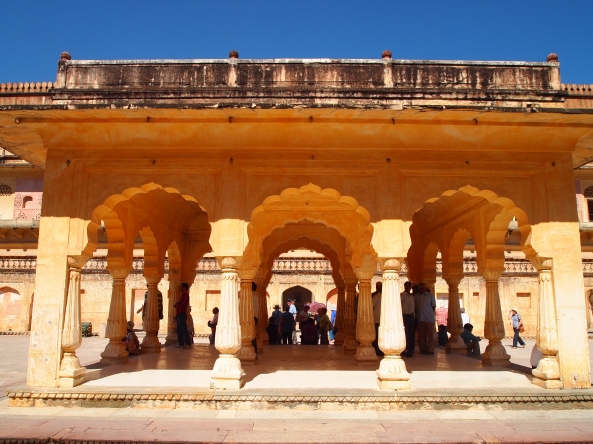
arches and arches
I am swept along with the hordes of tourists into another past and romantic century where chivalry was honored. When I finish exploring the maharaja’s chambers and the fancy gardens and beautiful architecture, I head back down where I find Jayne engrossed in a conversation with a cute young Indian guy. She is glowing and basking in the attention.

Jal Mahal, the palace in the lake
Sadly, we have to leave this place. We go back down to the parking lot where we meet Singh. We make a brief stop at Jal Mahal, a small palace set in the middle of Man Sagar Lake.
He then takes us to the Gatore Ki Chhatriyan , a site of the royal cenotaphs. It is such a beautiful and serene spot (rare in India), surrounded by a small village. The monuments inside are intricately carved and the whole spot is quite elegant. Small open air pavilions or gazebos are arranged in an artful pattern. Each gazebo has exquisitely delicate columns holding up white domes. The marble cenotaph of Maharaja Jai Singh II is quite impressive. Gatore Ki Chhatriyan was a royal crematorium site for Jaipur’s magnificent rulers. A cenotaph was constructed in recognition of each of the more famous maharajas cremated there. The royal cenotaph is known as “Chhatris” (umbrella-shaped memorial). The cenotaphs are engraved with magnificent Rajasthani carvings. Peaceful and soothing, it is one of my favorite spots in Jaipur.

Gatore Ki Chhatriyan was a royal crematorium site for Jaipur’s magnificent rulers. A cenotaph was constructed in recognition of each of the more famous maharajas cremated there.
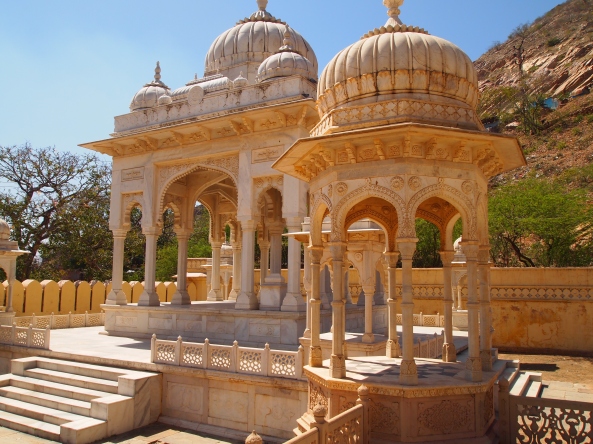
Gatore Ki Chhatriyan

Gatore Ki Chhatriyan

Gatore Ki Chhatriyan

Gatore Ki Chhatriyan

Gatore Ki Chhatriyan
Again, at this place, I go in alone as Jayne doesn’t feel like paying another entrance fee of 30 rupees. When I come out, she is busy talking with two Brazilians who are traveling around India selling jewelry. They comment on my havaianas flip-flops, which I bought in Korea but unbeknownst to me originated in Brazil! What a globalized world we live in!

the gate to the City Palace in Jaipur
Finally, Singh drives us back into Jaipur to see the fabulous Pink City. Singh drops us off at the City Palace gate. We hug him goodbye as this is the last time we will see him. He is heading back tonight to spend one night at home with his family, and then he has a three week tour with some girls from Australia. He says he is worried now because he has finally gotten used to our accents and now will have to get used to the Australian accent. We say our goodbyes and he is off. Suddenly, we feel a little lost.

a wandering musician in the Palace Cafe
We’re hungry so we go immediately to the Palace Cafe, where we eat another fabulous Indian lunch: Dal Palak, yellow lentils cooked with shredded spinach and Indian spices; Tandoori Naan; Bharwan Aloo, scooped potato stuffed with cashew nuts, cottage cheese, raisins and green herbs soaked in tandoor; Kingfisher beers and lemon rice. It’s expensive but delicious and we are able to relax in the lovely cafe and listen to a bright-red costumed and turbaned guy playing an interesting oboe-like instrument.

a pavilion in the Pink City’s City Palace
The modern-day city of Jaipur, known as the City of Victory, is the gateway to the desert state of Rajasthan. The Jaipur City Palace consists of a vast complex of courtyards, gardens and buildings, a blend of Rajasthani and Mughal architecture. The outer wall was built by Jai Singh, but other additions date from as recent as the early 20th century. After eating lunch we wander through the Maharaja Sawai Mansingh II Museum, which holds a collection of royal costumes and shawls, including Kashmiri pashmina (wool shawls).
We take pictures in a beautiful coral-hued pavilion with curlicue and floral white trim and then just wander around the palace until we are hot and tired. Sadly, somehow in all our explorations in Jaipur, we miss one of the most famous buildings, the Hawa Mahal, built in 1799 by Maharaja Sawai Pratap Singh. It is a 5-storied semi-octagonal monument that looks like a honeycomb. It’s funny, when you are traveling in such a place as India, you see so many beautiful forts and palaces and monuments that you sometimes get burned out from it all. There are things you miss just because you’re too tired and too stressed from trying to do and see everything. This is the hard thing about travel, deciding what is just too much and what is not enough.

More of the City Palace in Jaipur
After exploring the Palace, we have a lot of time to kill before our train leaves at midnight. We no longer have Singh waiting for us. We wander out and get into a rickshaw with the cutest Indian guy who has a very proper British accent. We think we want to go to shop at the bazaars, but of course this rickshaw driver wants to take us to the shops where he will get a kickback. We don’t want that and just want to wander by ourselves through a bazaar. He shows us a book where all his customers have written amazing things about him. He also keeps saying “Your wish is my command!” in a very British and very chipper tone. But eventually he gets fed up with us because we don’t want to go where he wants to take us or to buy anything at the shops where he has connections. He finally just insists that we get out at some random street corner, where he almost refuses to take my 50 rupee note because it has a lacy hole in it. After much argument, he takes it just out of sheer desperation to get rid of us!
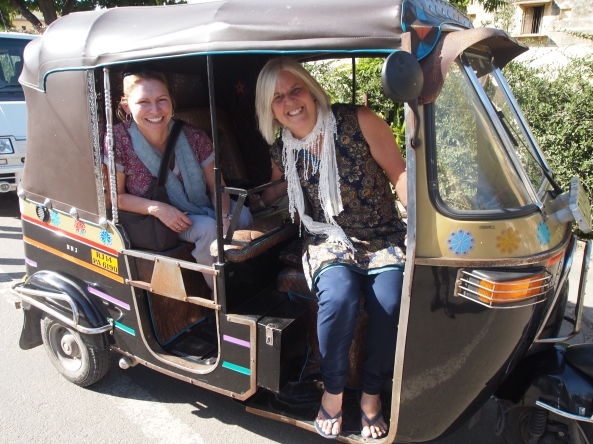
Our rickshaw through Jaipur ~ “Your every wish is my command!”
Later we find another rickshaw driver to whom we make an extremely low offer (all right, admittedly we are being cheap but we’re tired of being nickeled and dimed to death!) Our hotel is a little hard to find, so the poor guy drives around and around in circles desperately trying to find it. We end up giving him more than we originally agreed, thus rewarding him for his incompetence!!
Back at the hotel, we call another massage place where they send a car to pick us up. This is the Charak Ayurveda Clinic and Research Centre in Bani Park, Jaipur. We both have what is called the Ayurvedic massage with oil and hard rubbing and a head massage for 1,000 rupees. We realize we have spent lots of money on massages on this trip!! But it’s a nice way to relax after a long day of sightseeing.

Our masseuses in Jaipur ~ I have the short squat one
We are pretty greasy after this massage, but we no longer have a room and are unable to shower. We go to the rooftop of our lovely hotel, where we split a Kingfisher and a cauliflower tandoori dish and watch a lame puppet show. The puppeteer is a very skinny but cute Indian guy wearing balloon-like pants. He looks like a puppet himself. He asks me if I am a “fashion designer!” I have no idea where that question comes from! Then he tries to give us one of his puppets as a gifts, but we refuse knowing that we just cannot add anything else to our baggage. Also, as we know, with the acceptance of a gift such as this will come some obligation, to buy something else, perhaps.
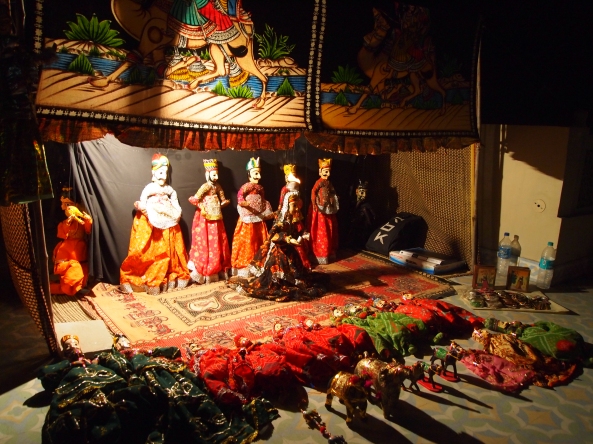
the set-up for the lame rooftop puppet show

the rooftop of Nahargarh Haveli where we eat some snacks and watch the puppet show
Later, we sit in the hotel lobby for hours waiting for midnight to arrive. We are sitting on these burgundy damask couches and I am reading White Tiger, which Jayne has finished and has passed on to me. The book is by Indian author Aravind Adiga and was first published in 2008; it won the Man Booker Prize in the same year. I can’t decide if it will be rude to lie down on the couch, but I am tired and feel like being in a reclining position. So I recline and hold the book over my head to read. Jayne and I start cracking up laughing over the inappropriateness of this, and I laugh so hard that I fart!! So embarrassing! By this time we are totally giddy.
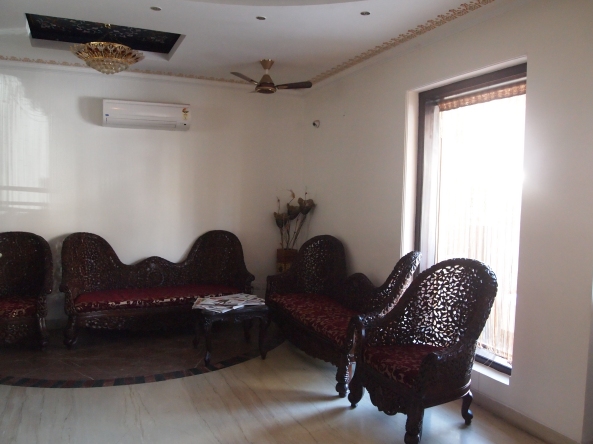
the lobby of the Nahargarh Haveli, where we spend hours reclining on the couches reading
Finally, at 11 pm, we get a rickshaw to the train station. This is a surreal and kind of scary experience. Signs are few and far between and there are 4 platforms; to get from platform to platform, we must climb steps to a bridge above. We are lugging our heavy suitcases and it’s a pain in the ass! We run back and forth on the platform, looking for the A1 coach, which is first class (we think, or we hope!). There seems no rhyme or reason to how the cars are lined up and we run back and forth in desperation, afraid of missing this train. Finally we find our car and lug our suitcase on board. We find our four-bunk compartment, separated from the aisle only by a curtain. The train is filthy! A couple is already ensconced in the top bunks, so we take the bottom. The girl is from America and the guy from Finland; they just happened to meet randomly on their travels. We all chat for a while and then settle in for the 12 hour train ride to Jaisalmer. Pure misery.















